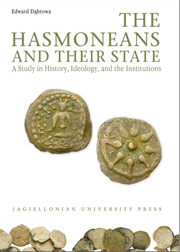Book contents
- Frontmatter
- Contents
- Introduction
- Abbreviations
- Part I Judea under the Hasmoneans (167–63 BCE)
- Part II The Institutions of the Hasmonean State
- I The Ruler
- 1 The Royal Priesthood or the Priestly Monarchy
- 2 The Priesthood
- 3 The Kingship
- 4 Succession
- 5 The Royal Family
- 6 The Court
- 7 The Capital City
- 8 The Palace and the Baris
- 9 Propaganda and Self-Presentation
- II The State
- Part III Society
- Conclusions
- Bibliography
- Index of Personal Names
- Index of Place Names
- Index of Ancient Sources
- Electrum - Volumes Published
- The Hasmonean State
8 - The Palace and the Baris
from I - The Ruler
Published online by Cambridge University Press: 05 September 2014
- Frontmatter
- Contents
- Introduction
- Abbreviations
- Part I Judea under the Hasmoneans (167–63 BCE)
- Part II The Institutions of the Hasmonean State
- I The Ruler
- 1 The Royal Priesthood or the Priestly Monarchy
- 2 The Priesthood
- 3 The Kingship
- 4 Succession
- 5 The Royal Family
- 6 The Court
- 7 The Capital City
- 8 The Palace and the Baris
- 9 Propaganda and Self-Presentation
- II The State
- Part III Society
- Conclusions
- Bibliography
- Index of Personal Names
- Index of Place Names
- Index of Ancient Sources
- Electrum - Volumes Published
- The Hasmonean State
Summary
Although Simon's capture of the Acra gave inhabitants of Jerusalem a full sense of security, he himself faced serious difficulty when, after a brief use of the former Seleucid fortress, he was compelled to demolish it. The difficulty lay in Jerusalem not having a convenient place in which to garrison the native troops so far stationed in the Acra. Their presence in the capital was indispensable to guarantee the ruler's personal safety and to ensure order in the city. This situation forced Simon to build an appropriate facility. Apart from a new citadel, Simon also needed a residence worthy of a ruler. The importance he is known to have attached to symbols emphasizing his own political standing suggests that he would not have forgone having an official residence that would manifest his personal power, but also testify to Judea's political independence. We can assume as fairly certain that Simon indeed managed to complete some of his plans in this respect. The account of 1 Macc suggests that some functions previously served by the Syrian Acra were taken over by the new citadel he built adjoining the Temple Hill to the north, known from a later tradition as baris. It became not just a quarter in which to station the garrison, but also the center of government as it also served as the Hasmoneans' residence until a specially designed palace could be built.
- Type
- Chapter
- Information
- The Hasmoneans and their StateA Study in History, Ideology, and the Institutions, pp. 132 - 133Publisher: Jagiellonian University PressPrint publication year: 2009



